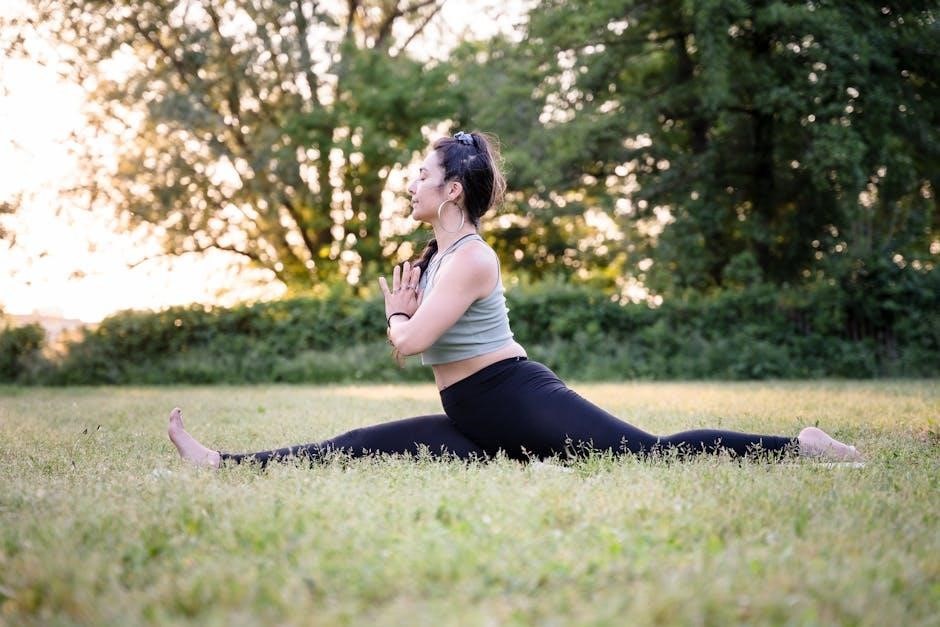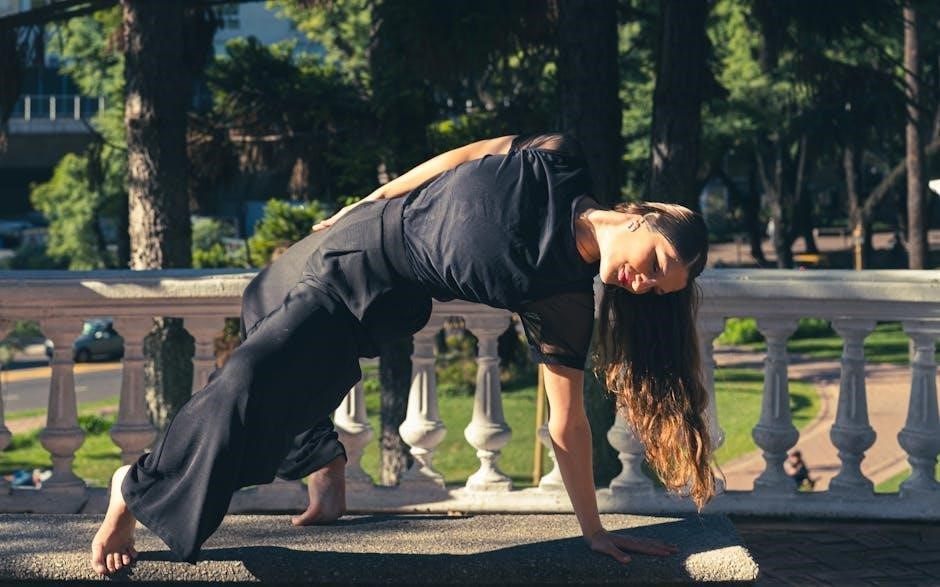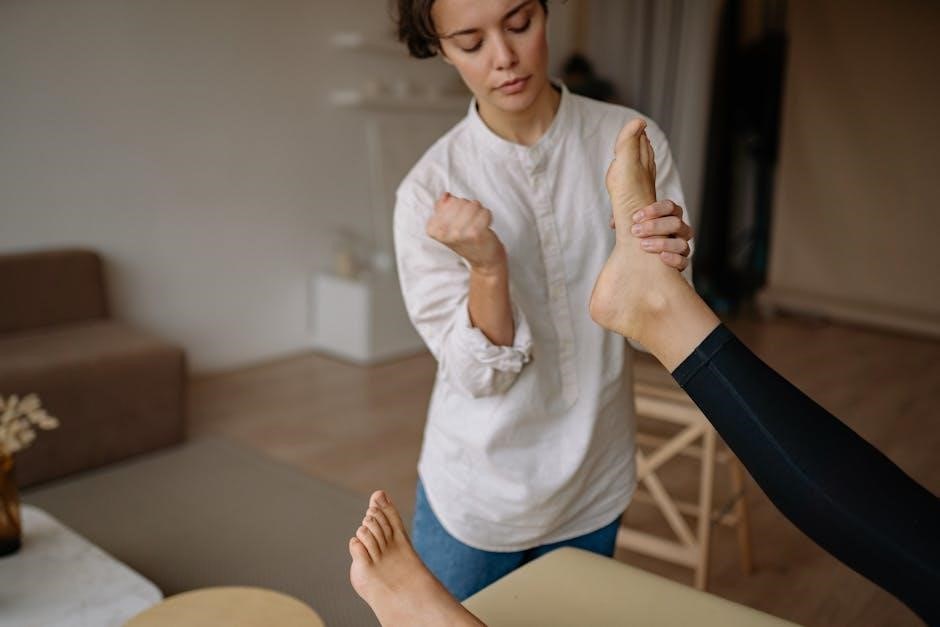The psoas muscle‚ located deep in the abdomen‚ plays a crucial role in hip flexion and spinal stability. Its proper functioning is essential for maintaining posture and preventing lower back pain‚ making it a key focus for stretching and strengthening exercises.
1.1. Understanding the Psoas Muscle and Its Role in the Body
The psoas muscle‚ located deep within the abdominal cavity‚ runs from the lower back (lumbar vertebrae) to the femur. It plays a vital role in hip flexion‚ posture‚ and spinal stability. As part of the iliopsoas muscle group‚ it works alongside the iliacus to facilitate movement. Tightness in the psoas can lead to lower back pain and poor posture‚ emphasizing its importance in maintaining proper body alignment and mobility. Regular stretching helps alleviate tension and improves overall musculoskeletal function.
1.2. Why Stretching the Psoas Is Essential for Mobility and Posture
Stretching the psoas muscle is crucial for maintaining optimal mobility and posture. Tightness in the psoas can lead to anterior pelvic tilt‚ lower back pain‚ and limited hip movement. Regular stretching helps restore flexibility‚ improves spinal alignment‚ and enhances overall movement efficiency. It also reduces muscle imbalances and promotes a more upright posture‚ making it essential for both sedentary individuals and active athletes. Incorporating psoas stretches into daily routines can significantly enhance comfort and performance in everyday activities and sports.

Benefits of Psoas Stretches
Psoas stretches reduce muscle tightness‚ improve hip flexibility‚ and enhance posture. They alleviate lower back tension‚ promote better movement patterns‚ and help maintain spinal alignment.
2.1. Relief from Lower Back Tension and Pain
Stretching the psoas muscle provides significant relief from lower back tension and pain. Tightness in the psoas often pulls the spine out of alignment‚ leading to discomfort. By releasing tension in the psoas‚ stretches help reduce strain on the lower back‚ alleviating pain and improving mobility. Regular psoas stretching can also address muscle imbalances and promote better posture‚ further reducing the risk of lower back issues. This makes psoas stretches a valuable tool for maintaining spinal health and overall well-being.
2.2. Improvement in Hip Flexibility and Range of Motion
Stretching the psoas muscle enhances hip flexibility and range of motion by releasing tension in the hip flexors. Tight psoas muscles can limit movement and cause stiffness‚ but targeted stretches help lengthen the muscle‚ improving mobility. This is particularly beneficial for athletes and individuals with active lifestyles‚ as it allows for deeper squats‚ lunges‚ and strides. Enhanced hip flexibility also promotes better alignment and reduces the risk of injuries during physical activity‚ making psoas stretches a cornerstone of effective mobility routines.
2.3. Enhanced Posture and Reduction in Anterior Pelvic Tilt
Regular psoas stretching helps correct posture by balancing the muscle’s tension‚ which often contributes to an anterior pelvic tilt. When the psoas is tight‚ it pulls the pelvis forward‚ creating a misalignment. Stretching releases this tension‚ allowing the pelvis to return to a neutral position. This reduction in tilt improves spinal alignment‚ enhances core stability‚ and reduces strain on the lower back. Over time‚ consistent stretching can foster better posture‚ reducing the risk of long-term musculoskeletal issues and promoting overall structural integrity.

Effective Psoas Stretches
Effective psoas stretches‚ such as the lunge‚ wall‚ and seated stretches‚ improve flexibility and reduce muscle tightness. These exercises target the psoas‚ enhancing mobility and posture naturally.
3.1. Lunge Psoas Stretch
The lunge psoas stretch is a highly effective exercise to release tension in the psoas muscle. Begin by kneeling on one leg‚ with the other foot flat on the floor in front of you. Slowly move your hips forward‚ keeping your back straight‚ until you feel a gentle stretch in the front of your hip. To intensify the stretch‚ raise the arm on the same side as the back leg and lean slightly backward. Hold for 15-20 seconds and switch sides. This stretch improves hip flexibility and reduces lower back tension effectively.
3.2. Wall Psoas Stretch
The wall psoas stretch is an excellent exercise for targeting the psoas muscle while providing stability. Start by standing in front of a wall and placing one foot on it‚ with your knee bent at a 90-degree angle. Slowly move your hips forward‚ keeping your back straight‚ until you feel a stretch in the front of your hip. To enhance the stretch‚ gently rotate your hips backward. This stretch is particularly effective for releasing tightness and improving mobility. Hold for 15-20 seconds and repeat on the other side. It’s a great option for those who prefer a more controlled environment for stretching.
3.3. Seated Psoas Stretch
The seated psoas stretch is a gentle yet effective way to target the psoas muscle. Sit on the floor with your legs extended straight in front of you. Bend one knee and bring your foot toward your opposite knee‚ placing your foot flat on the floor. Gently pull your knee toward your chest using both hands. You should feel a stretch in the front of your hip and lower abdomen. Hold for 15-20 seconds and repeat on the other side. This stretch is ideal for improving hip flexibility without putting pressure on the knee.
3.4. Standing Psoas Stretch
The standing psoas stretch targets the hip flexors and psoas muscle effectively. Stand near a chair or step and place one foot on it‚ keeping your knee bent at 90 degrees. Lean forward slightly‚ extending the same-side arm overhead‚ and gently arch your back. You should feel a stretch in the front of your hip and lower abdomen. Hold for 15-20 seconds and switch sides. For those with knee issues‚ a modified version without the step can be done by leaning forward while standing upright.
Psoas Stretches for Specific Needs
Psoas stretches can be tailored to address specific needs‚ such as relieving lower back pain‚ enhancing mobility for athletes‚ or improving posture for sedentary individuals. Regular practice ensures optimal results.
4.1. Psoas Stretches for Lower Back Pain
Tightness in the psoas muscle often contributes to lower back pain by pulling the spine out of alignment. Gentle stretches like the lunge psoas stretch and wall psoas stretch can help relieve tension. These exercises target the deep hip flexors‚ promoting relaxation and reducing strain on the lower back. Incorporating stretches that involve bending forward or leaning back slightly can also alleviate discomfort. Consistency is key‚ as regular practice helps maintain flexibility and prevent recurrence of pain. Always modify stretches to suit individual comfort levels.
4.2. Psoas Stretches for Runners and Athletes
For runners and athletes‚ tight psoas muscles can hinder performance and lead to injury. Dynamic stretches like high knees and leg swings are ideal pre-workout to maintain flexibility. Post-workout‚ incorporate static stretches such as the lunge psoas stretch or standing hip flexor stretch to release tension. Strengthening core muscles complements these stretches‚ enhancing overall stability and reducing the risk of strain. Regular practice improves hip mobility and endurance‚ ensuring optimal athletic performance and preventing tightness that can disrupt training routines. Consistency is key to maintaining peak physical condition.
4.3. Psoas Stretches for Office Workers and Sedentary Individuals
Sedentary lifestyles often lead to tight psoas muscles‚ causing discomfort and poor posture. Office workers can benefit from simple stretches like seated psoas stretches or wall psoas stretches during breaks. Gentle movements and deep breathing help release tension. Incorporating short stretching routines every hour can improve flexibility and reduce lower back strain. Strengthening exercises‚ such as pelvic tilts and bridging‚ also support psoas health. Regular practice helps alleviate tightness and promotes better spinal alignment‚ enhancing overall comfort and energy levels throughout the day.

Incorporating Psoas Stretches into Daily Routine
Incorporate psoas stretches into your daily routine by dedicating a few minutes in the morning and evening. Combine these stretches with strengthening exercises for balanced results and improved mobility.
5.1. Morning and Evening Stretching Routines
Starting your day with a morning stretching routine can improve flexibility and set a positive tone for mobility. Begin with gentle stretches like the wall psoas stretch or seated psoas stretch to awaken the muscle. In the evening‚ incorporate stretches such as the lunge psoas stretch or standing psoas stretch to release tension accumulated throughout the day. Consistency is key; perform these routines 2-3 times daily‚ gradually increasing intensity as flexibility improves. Combining these stretches with strengthening exercises ensures a balanced approach to muscle health and posture support.
5.2. Combining Psoas Stretches with Strengthening Exercises
Combining psoas stretches with strengthening exercises creates a balanced approach to muscle health. Strengthening the core and glutes through exercises like pelvic tilts and single-leg knee hugs enhances psoas function. This integration improves posture‚ reduces injury risk‚ and boosts overall mobility. Incorporate strengthening routines 2-3 times weekly‚ focusing on controlled movements to avoid overcompensation. Pairing stretches with strength work ensures the psoas operates efficiently‚ supporting both flexibility and stability for daily activities and athletic performance.
Safety Tips and Precautions
Start slowly‚ avoid overstretching‚ and use supportive tools like blocks or straps. Listen to your body and modify stretches based on comfort and fitness level.
6.1. Avoiding Overstretching and Injury
Start slowly and avoid intense stretches initially. Overstretching can cause discomfort or injury. Focus on gentle‚ controlled movements and stop if pain arises. Use props like blocks or straps for support. Prioritize body awareness and modify stretches to suit your flexibility level. Consult a professional if unsure about proper technique. Avoid bouncing or forcing beyond a comfortable range. Incorporate breathing to enhance relaxation and safety during stretches. Regular‚ gentle practice yields better results than aggressive overstretching.
6.2. Modifying Stretches for Different Fitness Levels
Modify stretches to suit individual fitness levels by adjusting intensity and using props like foam rollers or straps. For beginners‚ start with gentle stretches and gradually increase depth. Advanced individuals can deepen stretches or hold them longer. Use support‚ such as a chair or wall‚ for stability. Alternate between standing and seated poses to accommodate mobility limitations. Focus on controlled movements and breathing to enhance safety and effectiveness. Tailor each stretch to ensure comfort and avoid discomfort‚ fostering a balanced approach to psoas stretching.
Incorporating psoas stretches into daily routines offers numerous benefits‚ from improved mobility to reduced lower back pain. Consistency is key to achieving long-term flexibility and posture enhancement. Tailor stretches to suit individual fitness levels‚ ensuring safety and comfort. Combine stretching with strengthening exercises for optimal results. By prioritizing psoas health‚ individuals can maintain active lifestyles and prevent common musculoskeletal issues. Embrace these practices to foster overall well-being and enjoy a pain-free‚ balanced life.




About the author